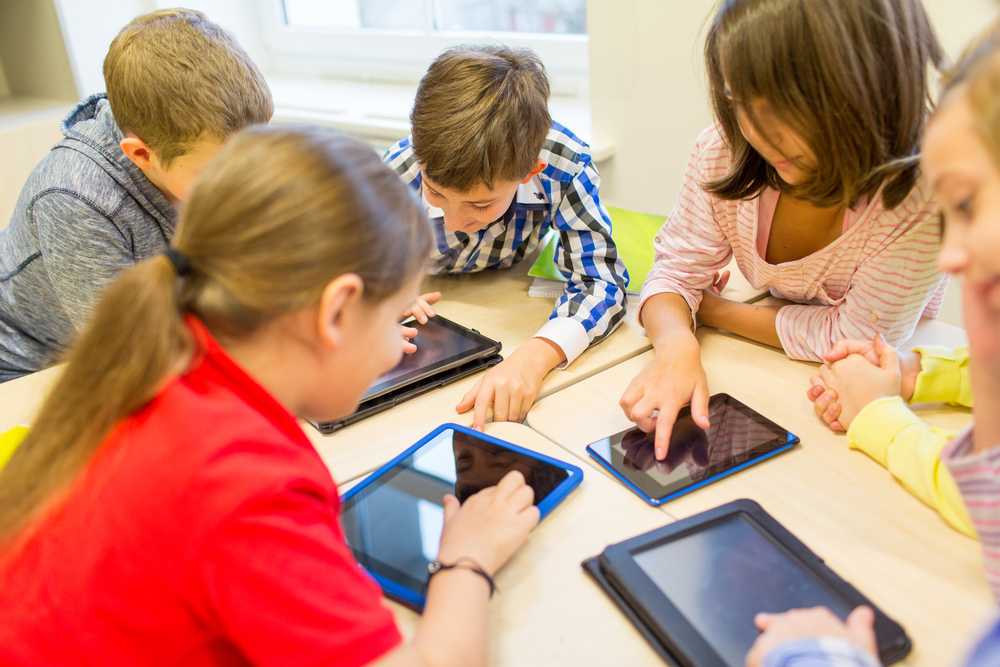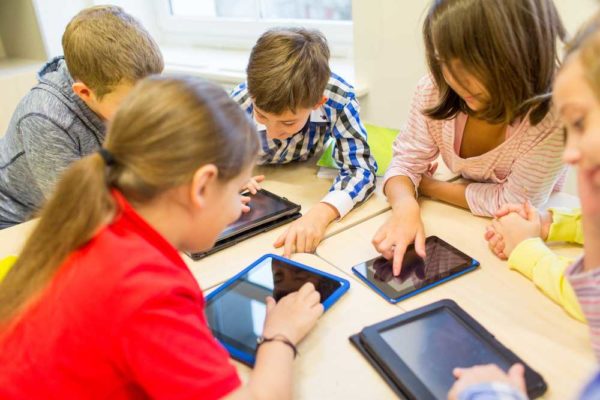Ed-tech expert Kathy Schrock weighs in on mixed platform solutions for all grade levels
 A few years ago, many school districts jumped on the iPad bandwagon, when they were still brand new. The fact is they were easy to justify for a purchase of a shared cart since the Apple app store had so many wonderful applications for remediation, practice, and extension. These districts purchased the first iPad, which did not mirror and, believe it or not, had no built-in camera. Other districts waited for the second version to be released, which did have a camera and could be mirrored via Apple TV or the Reflector app, but only purchased the model with 16GB of RAM.
A few years ago, many school districts jumped on the iPad bandwagon, when they were still brand new. The fact is they were easy to justify for a purchase of a shared cart since the Apple app store had so many wonderful applications for remediation, practice, and extension. These districts purchased the first iPad, which did not mirror and, believe it or not, had no built-in camera. Other districts waited for the second version to be released, which did have a camera and could be mirrored via Apple TV or the Reflector app, but only purchased the model with 16GB of RAM.
After a while, it became evident that maintaining a shared cart of iPads was no small feat. Taking care of the installation of apps and maintenance of the devices, as well as providing a positive experience for each shared user, was not easy. The 16GB of RAM was quickly eaten up by graphic-intensive apps, i-books, and PDF files, and the use of the camera for taking photos and videos. Schools began to think twice.
Enter the Chromebook, a device which was much cheaper and required little maintenance. However, even here there were difficulties at first as students needed to be attached to the internet to use the online Google tools and many of popular Flash-based sites were simply incompatible.
Fast forward to today and most of those bugs have worked themselves out. Devices have more memory and there are new features for both platforms that make them viable for use in the classroom. I truly believe a mix of devices is the best solution for schools.
The Apple App Store is full of well-vetted and useful software. When you hear “there is an app for that,” it seems to be true! From content-based applications that can be used for everything from remediation to enrichment, and apps that let students create videos, audios, simulations, infographics and more, the use of the iPad to support teaching and learning is truly remarkable. But the iPad really shines as a one-to-one device. Personalization, choice of apps and work that lives locally on the device make students feel connected with their iPad.
I recommend the Google Chromebook for a shared cart of devices. In conjunction with becoming a Google Apps for Education school or district, the Chromebook allows easy access to each user’s content. Since each student’s work lives in the cloud, and the Chromebook makes it easy for anyone with an account to log on to the device, it is perfect for a shared environment. There are now many extensions and HTML5-based online tools for the Chrome browser that allow students to do everything from editing images to using a math equation editor. And, the Chrome operating system now lets the student work on their Google Drive files when not connected to the Internet and syncs them up the next time they connect.
I also believe students of all ages need access to a full-featured computer. Stand-alone software, especially at the secondary level, provides students with the full-featured tools they need to create. For instance, Adobe Clip is a powerful iPad app that easily allows a student to create a video. But, for students that have the passion for movie-making, they need to have access to the full version of Adobe Premiere. In addition, access to a scanner, MIDI keyboard, powerful CAD and game-making software, a 3D printer, and any other computer-based hardware and software need to be available at point of need.
Next page: Kathy’s device recommendations for every age
I also believe students of all ages need access to a full-featured computer. Stand-alone software, especially at the secondary level, provides students with the full-featured tools they need to create. For instance, Adobe Clip is a powerful iPad app that easily allows a student to create a video. But, for students that have the passion for movie-making, they need to have access to the full version of Adobe Premiere. In addition, access to a scanner, MIDI keyboard, powerful CAD and game-making software, a 3D printer, and any other computer-based hardware and software need to be available at point of need.
I am often asked about recommendations for devices at the various grade levels of PreK-12. Here are my current thoughts and rationale for my choices.
PreK-Grade 1
With the huge number of content-based iPad apps that can support the early learner, the iPad is the best choice for this grade level. There are also easy-to-use creation apps for this age group that can be used to showcase acquisition of content. A full-size iPad (with at least 64GB of RAM) cart in each classroom, with an AppleTV and a large wall-mounted TV or monitor would be my recommendation.
Grades 2-4
For these grades, full-size, 64GB iPad Mini carts for each classroom, with the addition of keyboards, would be my recommendation. The smaller iPad Minis fit nicely in a student’s work area and when collaborating in a group with others. Again, an AppleTV and large wall-mounted monitor should be included in the classroom.
Grades 5-8
For the middle school student, I recommend a one-to-one Chromebook initiative, with the devices going between home and school if possible. With the off-line availability of Google Drive, these students can put their time on the team bus or at the dentist to good use. I would also recommend a cart of 64GB full-size iPads for every two to three classrooms to allow these grade levels to use the iPads for the creation of projects and products as assessments. In the classroom, Reflector 2 software (airsquirrels.com) running on the teacher’s Mac or Windows computer would be a good solution for mirroring student iPads to the desktop and viewable via the projector.
Grades 9-12
I would love to see all high schools investing in a one-to-one laptop initiative. However, I know this option is not within the reach of every district’s budget. So, my recommendation would be the same as for grades five to eight– a Chromebook for each student and and multiple full-size 64GB iPad carts in each department, In addition, having an iPad cart in the library, so students can work on creative projects there, as well as having “blinged-out” computer stations available with the more robust software and hardware, can also help meet the needs of students. Again, the addition of Reflector 2 software on the teacher’s Windows or Mac desktop should be considered for mirroring the iPads.
My resources to support mixed-platform schools
iPad information: ipads4teaching.net
Chromebooks in schools: www.schrockguide.net/chromebooks.html
Online tools: www.schrockguide.net/online-tools.html
Kathy Schrock is an online adjunct professor, an independent education technologist, and a nationally-known workshop and conference presenter. Find her online at online at Kathyshrock.net.
- TC- What student choice and agency actually looks like - November 15, 2016
- What student choice and agency actually looks like - November 14, 2016
- App of the Week: Science sensor meets your smartphone - November 14, 2016



Comments are closed.